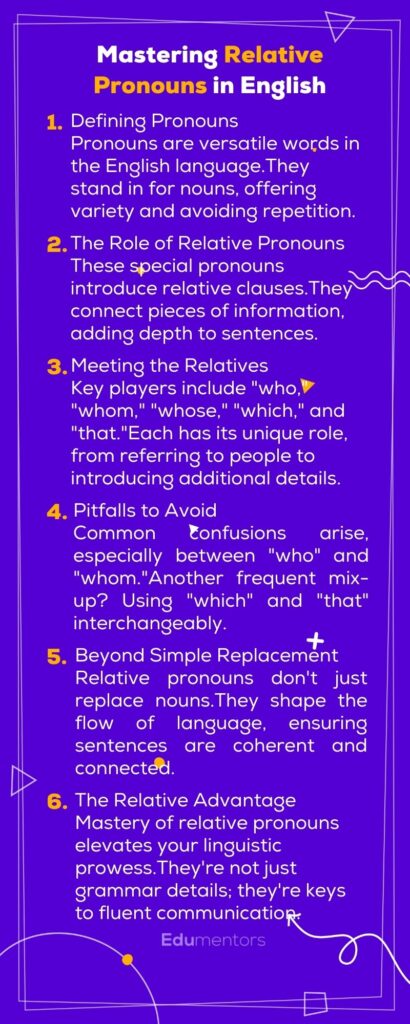Relative Pronouns
Every language has its unique tools to weave words into meaningful sentences, and in English, one of those essential tools is the relative pronoun. These connectors do more than just fill space; they create a rhythm in our speech and writing, guiding sentence flow with precision. By understanding their meaning, familiarising ourselves with a comprehensive list of relative pronouns, and practising with targeted exercises, we can enhance both our clarity and fluency. Let’s explore the foundational aspects of English grammar and underscore the significance of relative pronouns in our daily communication.

What exactly is a pronoun?
By definition, a pronoun is a word that takes the place of a noun, be it a person, place, thing, or idea. Its primary purpose? To prevent redundancy. Imagine always having to mention “Sarah” in every sentence when talking about her. “Sarah went to Sarah’s home because Sarah was tired.” Exhausting, right? This is where pronouns come to our rescue. They allow us to replace repeated nouns with words like “she,” “it,” “they,” and “we.” Thus, the sentence becomes, “Sarah went to her home because she was tired.” Cleaner, clearer, and undoubtedly more concise.
Diving deeper into the pronoun family, we come across a fascinating subset: relative pronouns. Unlike their pronoun siblings, relative pronouns don’t merely replace nouns. They serve a bigger role. They introduce relative clauses, essentially acting as bridges that connect ideas within sentences. These pronouns provide either essential information or additional information about a noun phrase. When used effectively, they can turn a simple sentence into a detailed, informative statement.
Consider the sentence, “The artist who painted this is renowned.” Here, “who” links the artist to the action of painting, offering crucial information about the noun.
List of Different Pronouns:
1. Personal Pronouns: Examples include “I”, “you”, “he”, and “she”, which replace specific names of people.
2. Demonstrative Pronouns: These are “this”, “that”, “these”, and “those”, pointing out particular items.
3. Possessive Pronouns: They show ownership and include “his”, “hers”, “its”, “ours”, and “theirs”.
4. Interrogative Pronouns: “Who”, “which”, “what”, “whom”, and “whose” are used to ask questions.
5. Reflexive Pronouns: Pronouns like “myself”, “herself”, “itself” relate back to another noun or pronoun in the sentence.
6. Indefinite Pronouns: “Someone”, “anybody”, “everyone” and “nobody” refer to non-specific persons or things.
7. Relative Pronouns: This category will be our focus today, diving deeper into their role and importance.
With this understanding of the broader category of pronouns, let’s now delve deeper into a particularly fascinating subset: relative pronouns.
Deep Dive into Relative Pronouns: What Are They?

As we navigate the diverse terrains of pronouns, one type invites special attention – relative pronouns. These aren’t just random linguistic components; they play an integral role in enhancing our communication.
Relative pronouns introduce relative clauses, acting as connectors linking different parts of a sentence. They add essential or additional information about a noun, making our sentences more descriptive and connected. Think of them as the bridges of the English language, providing smooth transitions and clarity.
The importance of mastering relative pronouns cannot be overstressed. Their correct usage not only makes your English sound more natural but also ensures precision in conveying intricate details. In the next sections, we’ll break down their types, uses, and common pitfalls, ensuring you wield this tool with finesse.
Table of Relative Pronouns
Navigating through English grammar, it’s immensely beneficial to have a structured layout to refer to. Below, you’ll find a comprehensive list of relative pronouns detailing their typical uses:
This table provides a snapshot of the main relative pronouns in English, showcasing their diverse applications. By understanding and referring to this relative pronoun list, one can enhance sentence construction, making communication clearer and more precise.
| Relative Pronoun | Use as a… | Refers to… | Example |
| Who | Subject | People | The woman who called was from the bank. |
| Whom | Object | People | The man whom I saw yesterday is my uncle. |
| Whose | Possession | People | The girl whose bag is red is my cousin. |
| Which | Subject/Object | Things, Animals | The cake which is on the counter is for the party |
| That | Subject/Object | People, Things, Animals | The dog that barked loudly is friendly. |
Common Mistakes with Relative Pronouns
Navigating the realm of relative pronouns can sometimes lead to common missteps. By understanding these and the underlying grammar rules, we can ensure clearer communication. Let’s delve into some of the frequent mistakes and their corrections:
1. Who vs. Whom
❌: The person who I was speaking to is my manager.
✅: The person whom I was speaking to my manager.
Explanation: Use “whom” when referring to the object of a verb or preposition.
2. Restrictive vs. Nonrestrictive Clauses
❌: My sister, who is a nurse, lives in Boston. (Assuming you have only one sister)
✅: My sister who is a nurse lives in Boston.
Explanation: Don’t use commas for restrictive clauses that are essential to the sentence’s meaning.
3. Omission of the Relative Pronoun
❌: The movie which I watched was thrilling.
✅: The movie I watched was thrilling.
Explanation: Sometimes, especially in informal speech and writing, the relative pronoun can be omitted when it’s the object of the verb.
4. Using ‘That’ for Non-restrictive Clauses
❌: My car, that is blue, needs a wash.
✅: My car, which is blue, needs a wash.
Explanation: Use “which” for non-restrictive clauses that add additional information but aren’t essential to the main point of the sentence.
5. Ambiguous Reference
❌: She gave a book to the student that had a red cover.
✅: She gave a book with a red cover to the student.
Explanation: Ensure the relative pronoun clearly refers to its intended noun for clarity.
Remember, mastering these rules doesn’t just mean understanding them. It means practising them until they become second nature, ensuring your language is both precise and engaging.
Test Yourself: Relative Pronoun Exercises
True mastery of any skill is best assessed through hands-on challenges. Now that you’ve gained an understanding of relative pronouns, it’s time to put that knowledge to the test. Here are some relative pronoun exercises designed to gauge your understanding and help you achieve linguistic mastery:
Fill in the blank with the correct relative pronoun:
"The artist ____ painted this masterpiece is world-renowned."
a) which
b) who
c) that
d) whom
b) who
Select the best relative pronoun to complete the sentence:
"There's the dog ____ bit the postman last week."
a) who
b) whose
c) which
d) whom
c) which
Choose the right pronoun: "The lady to ____ I spoke earlier is the manager."
a) whom
b) who
c) which
d) that
a) whom
Identify the mistake in the following sentence: "The book, that has a blue cover, is my favourite."
a) Use "who" instead of "that"
b) The sentence is correct
c) Use "which" instead of "that"
d) Omit "that"
c) Use “which” instead of “that”
Choose the appropriate relative pronoun for the sentence: "The house ____ I grew up in has been demolished."
a) which
b) where
c) who
d) whom
a) which
Feedback: How did you do? If you aced these exercises, congratulations on reinforcing your mastery! If there were hiccups along the way, don’t worry. Like any skill, linguistic prowess is honed with time and practice. Revisit the sections above, challenge yourself with more exercises, and soon enough, you’ll master the art of using relative pronouns with precision and confidence.
Conclusion
The vast landscape of the English language is dotted with numerous elements, each contributing to its richness. Among these, relative pronouns stand out, not just as mere words, but as pivotal tools for effective communication. Their importance cannot be understated. Whether we’re crafting intricate essays or engaging in daily conversations, a grasp on relative pronouns elevates our language, bringing about fluency and proficiency.
Yet, as with all aspects of language, understanding relative pronouns isn’t a one-time event; it’s a journey of continuous learning. With every conversation we have, and with every piece we write, we further cement our knowledge of these connectors, making relative pronouns in English an intrinsic part of our linguistic toolkit.
As we conclude, remember that the journey to mastering any element of language is ongoing. But with dedication, practice, and a keen eye on the nuances, one can seamlessly weave these pronouns into the fabric of their communication, enhancing clarity and resonance. So, keep learning, keep practicing, and let the world of relative pronouns enrich your English narrative.









